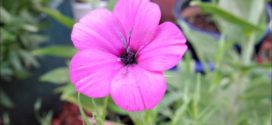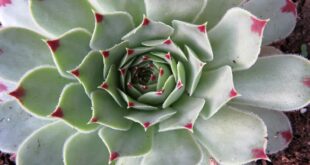Teucrium fruticans azureum (Bush Germander) is a reliable foliage and flowering accent plant. It develops into a large evergreen shrub, 4-8 ft. high, spreading 8-10 ft. across. Distinctive foliage is gray-green above with silvery white hairs beneath. Colorful pale lavender flowers are heaviest in winter to early spring and intermittently throughout the year. Bush germander comes from rocky slopes in …
Read More »Tag Archives: drought
Osteospermum ‘Zion Copper Amethyst’
A stunning “African Daisy” with 2” wide, tricolor blooms that practically glow! The flowers open bronzey-orange then, as they age, color-shift from the center out starting with hot-pink followed by a rich purple. Color can vary seasonally, often starting out almost entirely bronze-hued in Spring and transitioning to primarily purple as the season progresses. Perfect for adding brilliant color to …
Read More »Lobster Flower
A perennial, aromatic, succulent herb, which grows as a ground-hugging wide spreading mat under 1 foot tall (a little taller in shade or when well watered) with rounded slightly scalloped gray-green foliage and deep blue and purple flowers that rise 3 to 6 inches above the foliage from spring through late fall (some say they bloom year-round). This plant makes …
Read More »Pink German Catchfly
Pink German Catchfly (Viscaria oculata) is a pretty annual. Each 1-inch flower has five petals around a dark eye. Ours started blooming May 20. They bloom for about 4 months. The common name “catchfly” is used because the stems secrete a sticky liquid that traps small insects. The flower has been in British gardens since the 1840s. No flower seed …
Read More »Bidens
Easy-care and long-blooming Bidens is easy to recognize in garden beds and borders, as well as container gardens. A cheery annual native to areas of southwestern North America, it features golden-yellow daisy-shaped flowers that continue to appear for weeks. This family of plants earned these names thanks to their clinging seeds, which look something like ticks and stick to clothing …
Read More »Hen-and-Chicks
New to our Sunnyvale garden in 2020 are Hen-and-chicks (Sempervivum tectorum ‘greenii’). This succulent forms a mat of rosettes, each 4″ across and only 2″ tall, in a lovely shade of blue-gray with each leaf tipped in deep red. Our plant was purchased from Annie’s Annual in Richmond. Older rosettes produce short stems of pink, narrow-petalled blossoms and then die, …
Read More »California Fuchsia
California Fuchsia (Zauschneria x cana ‘Calistoga Hybrids’) is a ground covering California native with large number of flowers that smother showy grey-green leaves on this low-water, low-maintenance, deer resistant, drought tolerant plant. Grown for its broad, grey leaves, low form and boldly colored carmine flowers, California Fuchsia prefer loose drainage, but adapt easily to clay soil. Plants do tend to …
Read More »Texas Sage
Our Sunnyvale garden has many drought-tolerant plants such as succulents, lavenders, and salvias. Texas Sage ‘Green Cloud’ is a recent purchase from Yamagami Nursery in West San Jose. Texas Sage (Leucophyllum fruitescens) has many common names, including Texas ranger, Texas rain sage, barometer bush, cenizo, silverleaf, and ash-leaf. The plant is not a sage (Salvia ssp.) but it is native …
Read More »Tufted Evening Primrose
Tufted evening primrose (Oenothera caespitosa) is a night bloomer, producing large white flowers that start to open in late afternoon and on into the night. The fragrant blossoms appear to glow in the dark while attracting nighttime pollinators. Once the sun begins to rise, the white blooms fade to a lovely shade of pink that decorates the garden throughout the …
Read More »







